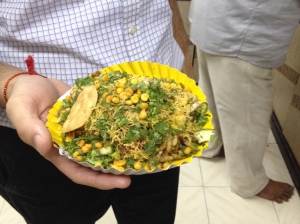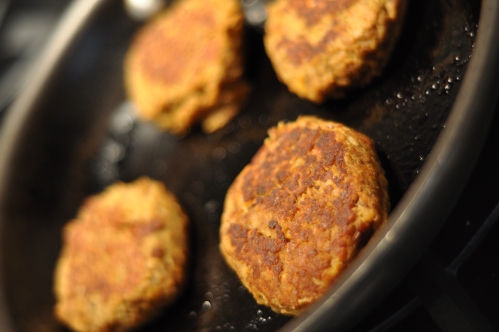Lauki in Hindi, Bottle Gourd in English aka Opo Squash and Long Melon, this vegetable is a staple of Indian cooking and one that I absolutely hated growing up. Eggplants were also on the list of disliked vegetables but I love them both now. In fact, the only vegetable that I disliked as a I child that I continue to consider unfit for human consumption is Karela (Bitter Gourd). I love just about everything else. Funny how tastes change with age. But I digress.
I had bought a Lauki from an Indian store to make Sambar. These veggies tend to be on the massive side, so I had just used half of it. The other half was calling my name for dinner last week and I was ready to make the standard Lauki/Chana Daal but there was a Bell Pepper that had been whispering my name in the fridge as well. So for a lark, I decided to go to one of my favorite go-to Indian sites for ideas – Vahrehvah.com. Sure enough, there was a recipe for Chana Daal with Lauki and Capsicum (Bell Pepper) – link here. I made a variation of this that night along with Parathas. It turned out quite well, though you may want to go a little easier on the red chili than the recipe calls for.
Anyway, when dinner was served that night, my older daughter turned to me and said – “Daddy, where did you get the Parathas from?”. When I replied that I made them, I was greeted with an incredulous “Really? You know how to make Parathas?”. Jeez, I get no respect. Anyway, my variation is below (it is approximate since I was winging it). Enjoy.
INGREDIENTS (enough for 4)
1 cup Chana Daal (Split Pea) – soaked in water that just covers the daal for 2 hours or so. Longer is better
1/2 a medium sized Bottle Gourd – peeled and cubed into 1 inch pieces. The Bottle Gourd I stared out with was about a foot long.
Salt to taste
1 Tbsp Olive Oil
1/2 tsp Cumin seeds
1/2 medium Onion sliced thin
4 cloves of garlic – minced
1.5 inch of Ginger – peeled and minced
1 tsp Coriander powder (preferably fresh)
1/2 tsp Red chilli powder
1/4 ts Fennel seed powder
1 large Tomato chopped
1 Bell pepper, cut into cubes
1/4 tsp Garam masala powder
STEPS
- Boil the soaked Daal, Bottle Gourd pieces and a little salt in some water (enough to cover them all but no more). Lower heat to medium and allow them to cook till the Daal is soft and the Bottle Gourd is cooked. Try and get as little water remaining as possible.
- In a pan, heat the oil on Medium High, add cumin seeds. When they sputter, add the onion slices and a pinch of salt. Saute till the onions are translucent.
- Add the Ginger, Garlic and cook till the raw smell is gone. Add the Coriander, Fennel and Red Chili powders.
- Add the tomatoes and cook till pulpy. Add a little water (about 1/2 cup)
- Add the cooked Daal and Bottle Gourd and the Bell Pepper.
- Cook the mix for another 2-3 minutes.
- Add the Garam Masala, mix well and serve with an Indian bread of your choice.













